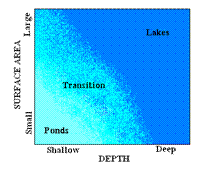Home → Water Quality → Sample Link 1 → Sample Link 1.2
Lake or Pond???
One of the most frequently asked questions posed of biologists in the Lake Assessment Section of Maine DEP, is what makes an inland body of freshwater a lake or a pond? About half of the 6,000 lakes and ponds that have been assigned a state identification number have been named, many having two or three names. At least thirty have one name with the word lake in it and the other with the word pond. For example, Bryant Pond is also known as Lake Christopher and Dexter Pond sports the name Wassookeag Lake! It is often these dual names that make folks wonder exactly where do we draw the line in Maine?
One classic distinction is that sunlight penetrates to the bottom of all areas of a pond in contrast to lakes, which have deep waters that receive no sunlight at all. Another is that ponds generally have small surface areas and lakes have large surfaces. So a combination of surface area and depth are considered from a technical perspective.

Some of our waters are definitely lakes – they are both large and deep – indisputably lakes. Others are ponds – small and shallow. And there is a transition between the two where the definition becomes fuzzy. If we held to the depth distinction, some ponds would become lakes mid-summer when algal populations limit light penetration to the bottom. The surface area distinction makes no sense for seven-acre waters that are 50 feet deep (like Maine’s kettle ponds), or for 400-acre waters that have emergent vegetation across their entire surface.
So to answer the question above: no definitive line exists between lakes and ponds. The one distinction that has any legal application is the designation of a water as a Great Pond. Maine state statues define lakes and ponds greater than ten acres in size as Great Ponds. If an impounded water is greater than thirty acres in size it is also legally considered a Great Pond; impounded waters less than thirty acres that were greater than ten acres before dammed are also Great Ponds.
Thus there is no exact technical distinction between lakes and ponds. All lakes and ponds provide critical habitat for other living creatures – aquatic macroinvertebrates, plankton, fish, wildlife and vegetation – and all need protection, so that clean fresh water continues to be one of Maine’s premier natural resources.
For more information about lakes, please contact Linda Bacon at the Maine Department of Environmental Protection at (207) 441-0462.